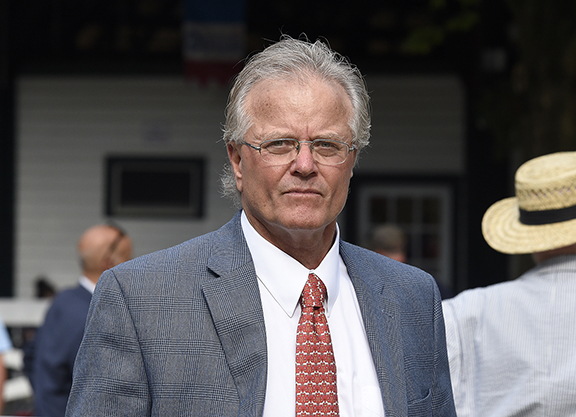By T. D. Thornton
While newly christened Horse of the Year Gun Runner (Candy Ride {Arg}) carried last week's on-track headlines with his scintillating score in the GI Pegasus World Cup, there was no shortage of behind-the-scenes news percolating out of various racing commission meetings, lawsuits, and legislative efforts.
Bill Mott's legal crusade against the New York State Gaming Commission (NYSGC) has all the elements of a fight worth following, both from the perspective of the Hall-of-Fame trainer wanting to clear his own name and for Mott's stated desire to establish a legal precedent to protect other trainers who similarly believe they have been wronged by the NYSGC's drug-testing process.
March 9 is now the next court date for Mott's ongoing lawsuit against the NYSGC, which traces back to a pair of alleged medication overages in 2014, but has since escalated into a civil rights case based on the commission's failure to provide the trainer with split blood samples to defend the allegations made against him.
State court action in Mott's suit had been stayed pending the outcome of his NYSGC hearing report and results order. But that portion of the case reached a regulatory conclusion Jan. 22 when the NYSGC voted to concur with a hearing officer's recommendation that Mott is responsible for an overage of the therapeutic drug flunixin (Banamine) in Saratoga Snacks (Tale of the Cat), who finished sixth and last at Belmont Park Sept. 20, 2014.
Even though the hearing officer deemed that Mott presented substantial evidence that he was not responsible for an improper third-party administration of furosemide (Lasix), the NYSGC still voted to uphold the original 15-day suspension and $1,000 fine handed down by the Belmont stewards based on the two original alleged violations (last week's TDN story here).
Upon first learning of the penalty last Monday, Mott's attorney, Andrew Mollica, termed the NYSGC decision a “travesty of justice.” In the days since, Mollica has had time to digest the hearing officer's report in its entirety and attend a Thursday status hearing with a judge about how the court case will proceed.
Beyond finding it incredulous that some 2,000 pages of testimony transcripts got “glossed over” and boiled down into just a 17-page recommendation, Mollica said via phone on Friday that the NYSGC's decision to cast aside the alleged Lasix infraction while not reducing the original penalty demands further scrutiny.
“On further reflection after looking at that order, what stands out to me is that [the hearing officer] found [the state's testing lab to be] not right on the Lasix,” Mollica said. “Well, we take the position that if the [testing for] Lasix isn't right, then neither is the Banamine.”
The hearing officer's report established that when Mott initially requested a “referee” sample of the body fluids sampled from Saratoga Snacks, only the urine sample was delivered to the testing facility because the blood sample had been “consumed in the testing” at the NYSGC-approved lab.
The report, authored by Robert Liebers (an attorney who is an independently contracted hearing officer, and not a full-time commission employee), also asserted “There was no bad faith by failing to preserve a blood sample…. The fact that Dr. [George] Maylin [director of the New York Drug Testing and Research Program] testified that he would prefer to have more blood drawn does not create bad faith…. The fact that Dr. Maylin and [Mott] both believe that there could be a better system does not equate to bad faith.
“In summary, the system here worked as designed,” Liebers concluded.
Mott and Mollica strongly disagree with the hearing officer on that last point.
“So we're now in a holding pattern, which is fine,” Mollica said. “All court battles take a long time, and this one's going on 3 1/2 years so far.”
Alternate Preakness Pitch
A years-long $426,000 study conducted by the Maryland Stadium Authority over the future of Pimlico Race Course edged closer to a second phase when the Maryland Racing Commission voted Jan. 25 to approve state funding to allow the analysis to continue.
The project still requires additional legislative sign-offs before it advances further, and it's important to keep in mind that this initiative is only the research phase to determine if the home of the second jewel of the Triple Crown is worthy of a $250-300 million refurbishment–it is not the actual renovation or rebuild of the Maryland Jockey Club (MJC)-owned track itself.
According to the Baltimore Sun, completion of the study in 2018 will involve “analysis of the neighborhood surrounding the track and of possible non-racing uses for the facility,” with the goal of being able to use the information that is gathered to debate Pimlico's future during the 2019 General Assembly session (full story here).
But at least one state representative doesn't think the Maryland legislature will ever fund a Pimlico rehab, and that studying that scenario further is a passive waste of time.
Delegate Patrick McDonough, a Republican running for Baltimore County executive, told the Sun he'll be filing a bill to create a public-private commission to instead research building a brand-new “state-of-the-art” racetrack elsewhere in Baltimore County as part of a grand-scale sports and entertainment complex.
Without it, McDonough said he believes the GI Preakness S. is in danger of being transferred by the MJC to its sister track, Laurel Park, which sits roughly 30 miles south in Prince George's County.
“I'm trying to stimulate debate on the subject,” McDonough told the Sun. “When politicians sit on their butts, bad things happen…. This is a major sporting event. Losing it would be like losing a professional team.”
McDonough added that Baltimore County has ample open space to accommodate a sports-and-racetrack facility, and he is advocating for private funding of the project.
Ark Sinking?
Remember all the buzz about the Ark a few months ago? In September, the TDN profiled the first racehorse to clear quarantine through the new $65 million, privately owned, full-service animal transit facility at Kennedy International Airport.
For international Thoroughbred shippers, the equine portion of the 178,000 square-foot, climate-controlled, veterinarian-staffed complex built adjacent to the JFK runways was supposed to offer inbound New York horses a faster, better alternative to vanning two or three hours to a United States Department of Agriculture (USDA) facility in Newburgh, New York.
Now, four months later, the Ark is incurring “massive operational losses” and is in imminent danger of closing, the facility's owner, John Cuticelli Jr., told the New York Times last Wednesday.
Although the Ark was designed to house many types of imported animals, racehorses had been projected to be key clients. Cuticelli also operates the Cornell Ruffian Equine Hospital just outside the Belmont Park stable gate.
In September, Cuticelli told TDN that the opening of the Ark “will lead to a lot more horses shipping to the U.S. or shipping to race in other countries. It's all about how the horses are cared for. When a horse comes through here, that horse is ready to run. That's our goal. So we believe it is a foregone conclusion that we will help make it easier for horses to ship around the world.”
According to the Times, Cuticelli recently filed a $426 million lawsuit in State Supreme Court in Queens against his landlord, the Port Authority of New York and New Jersey, based on a claim that the Port Authority is failing to enforce the “exclusive rights” part of the Ark's lease that pertains to the intake of animals coming to the airport from outside the country.
The story cited an added cost of several hundred dollars per animal as a potential reason transporters are bypassing the Ark for the Newburgh facility. But it also pointed out that Cuticelli “does not know whether he has stumbled into some bureaucratic nightmare with the Port Authority, a turf war between government agencies, or is the object of a boycott” by livestock shipping agents and transporters.
“It makes no sense to me why the Port Authority, the USDA and all the other agencies involved in the creation of this facility are not supporting its use,” Cuticelli told the Times. “I entered into a technically, legally binding contract with exclusivity. Otherwise, I never would have done it.”
The Times reported that Dora Delgado, a senior vice president of racing and nominations for the Breeders' Cup, sent a December letter to the USDA expressing “concerns about the Port Authority's plans to require 'international equine athletes' to use Ark,” when flying into New York instead of allowing owners to utilize other USDA-approved quarantine options.
“The 40 or so racehorses a year that fly into Kennedy from Europe, Japan and elsewhere for races within two weeks of landing represent only a fraction of the total expected volume,” the Times reported.
Not a subscriber? Click here to sign up for the daily PDF or alerts.






